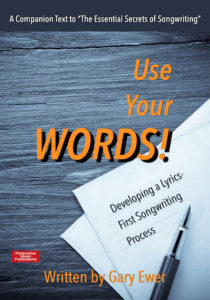A pre-chorus is not a mandatory section of a song. In fact, most songs don’t use them. But in some circumstances, a pre-chorus can be a vital addition to the structure of a song.
It sits between the verse and chorus, and its main purpose is to better prepare the listener for the arrival of the chorus, particularly when:
- The verse seems very short; and/or…
- The verse uses a repetitive melodic cell, or is otherwise somewhat unadventurous; and/or…
- The verse and chorus melodies are the same or similar; and/or…
- The verse chord progression is very simple, and/or is the same as the chorus chords.
In other words, your verse may sound great, but if it sounds like the chorus is arriving too soon, you’ll want something to make the listener wait a bit for that chorus. That’s where a pre-chorus fits the bill nicely.
 Trying to get a handle on writing song lyrics? Discover the benefits of making a lyrics-first method your new go-to process with”Use Your Words! Developing a Lyrics-First Songwriting Process. It’s FREE right now when you purchase the 10-eBook Bundle.
Trying to get a handle on writing song lyrics? Discover the benefits of making a lyrics-first method your new go-to process with”Use Your Words! Developing a Lyrics-First Songwriting Process. It’s FREE right now when you purchase the 10-eBook Bundle.
There are lots of examples of pre-choruses, but one that seems very instructional — a kind of textbook example — is Sugarland’s “Stuck Like Glue,” which I’ve mentioned before on this blog.
Pre-Chorus Chords
So what should a chord progression in a pre-chorus do? It needs to serve as a good transition, of course, but it works best if it builds musical energy while making that connection.
With chords, musical energy is built when tension builds. Since most chord progressions (particularly in pop songs) are all about the journey away from and back to the tonic chord, a pre-chorus progression is usually constructed in such a way that its final chords want to seek out the tonic chord.
In “Stuck Like Glue”, which gives us a rather short pre-chorus of 2 bars, only two chords are necessary:
- Verse: Db Ab Gb (4 times)
- Pre-chorus: Ebm Ab
- Chorus: Db Ab Gb…
In other songs, the pre-chorus can be longer, perhaps 4 bars or more. In those cases, the number of chords will be greater, of course, but the job is the same: to build musical energy by seeking out the tonic chord.
However many chords you use will depend on how long your pre-chorus section is, and the length of the pre-chorus will usually be determined by how long the verse is. This part is usually guided by instinct; you can just tell when a pre-chorus is going on a bit too long.
So the most important feature of a pre-chorus progression is the building of tension. If you have a chorus that starts on a I-chord, it’s best if the pre-chorus progression ends on something that moves smoothly to that I-chord. Assuming a key of C major, here are some examples of usable pre-chorus progressions (all of which can be repeated as needed):
- Dm F Am G
- F C/E Dm G
- Am F Dm G
- Em Am F G
- G Am D7 G
 Written by Gary Ewer. Follow Gary on Twitter.
Written by Gary Ewer. Follow Gary on Twitter.
 “The Essential Secrets of Songwriting” 10-eBook bundle includes several chord progression eBooks, including “Chord Progression Formulas”. Learn how to create chord progressions within seconds using these formulas.
“The Essential Secrets of Songwriting” 10-eBook bundle includes several chord progression eBooks, including “Chord Progression Formulas”. Learn how to create chord progressions within seconds using these formulas.











Pingback: The Daily Muse – May 2nd, 2020 | All About Songwriting